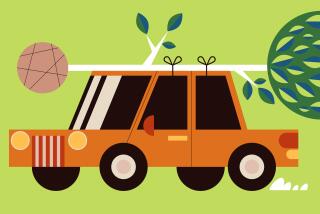Grass-Roots Effort : Local nursery owners offer some advice on planting a perfect lawn--and saving money.
- Share via
If the grass is always greener on the other side of the fence, you may want to change your attitude about life--or you may want to plant some new grass.
The arrival of spring is a good time to do both.
We will leave the brain work to you. But after speaking with some local sod sellers to get tips on planting new lawns, we can offer some help with the yard work.
*
“The next three months would be an excellent time to plant new turf,” said Glenn Izard, owner of Nordic Nursery in Newbury Park. “You’ll get a chance to get the roots in the ground before we have the hot spells of summer.”
Assuming you already have a lawn, the first step to planting new grass is to kill off the old grass, roots and all.
Izard suggested applying an herbicide, letting it sit for two weeks and removing the turf with a sod cutter or a shovel. Next, rototill the dirt, install or fix the sprinkler system and add organic material--a wood compost and an organic humus--to fortify the soil and to feed the incoming root system.
Once the field is set, it’s time to install the sod pallet.
*
If you aren’t familiar with the name Southland Sod, you probably will be by this stage. The Port Hueneme company is the leading sod grower in the area, and at least a dozen local nurseries sell the Southland product.
“To choose the proper turf, you need to determine whether there’s a lot of shade, a lot of sun, whether there will be high traffic [on the lawn] or low traffic,” Izard said.
For most Ventura County lawns, he said, the best grass would be one of Southland Sod’s Marathon brands of fescue. It can survive in full sunlight (with a minimum of five hours of sun daily) and a moderate amount of foot traffic. And it will stay green year-round.
The price of turf at Nordic Nursery is 33 cents per square foot. The necessary amendments (to help the grass flourish) are 10 to 12 cents a square foot.
The sod suppliers we spoke with agreed that home owners generally are capable of planting their own sod. Izard said about half his sod customers plant their own; the other half hire a gardener.
“If you hire a gardener, you’re looking at about $1 a square foot for everything--it would be more if you have to take out an old lawn,” he said. “So you save about two-thirds in cost doing it yourself.”
Nordic Nursery provides rollers and rakes at no charge for customers who buy sod and install it themselves.
*
Todd Toner, manager of the Ojai Valley Nursery, recommends fescue sod for areas with a lot of sunlight. For shady locations, he suggests a seed blend--a combination of bluegrass, creeping fescues and rye grass.
“Most growers of fescue sod say it will do well in the shade, but I’ve found it doesn’t,” Toner said. “Definitely you need to know whether a location is sunny or shady or a filtered area.”
Ojai Valley Nursery sod is priced at 35 to 45 cents per square foot.
*
Kevin Gysler, manager of Enchanted Way Nursery in Simi Valley, said that soil preparation is the most important part of the planting process.
“Soil preparation will get your lawn going,” Gysler said. “You need to refresh the soil every time you plant. Amendments are all organic, and organics naturally degrade in soil.”
For Ventura County’s generally rocky or sandy soil, Gysler suggests preparing a 1,000-square-foot piece of soil with 10 2-cubic-foot bags of humus mulch, eight 3-cubic-foot bags of redwood compost and three 50-pound-bags of a gypsum and soil sulfur mix (gypsite) for 1,000 feet of sod.
The price for the hardiest Marathon sod is 34 cents per square foot at Enchanted Way Nursery. Humus mulch is $4.79 a bag, redwood compost is $8.49 a bag and gypsite is $6.29 per bag.
*
Now that that’s done, you can work on that attitude of yours.






